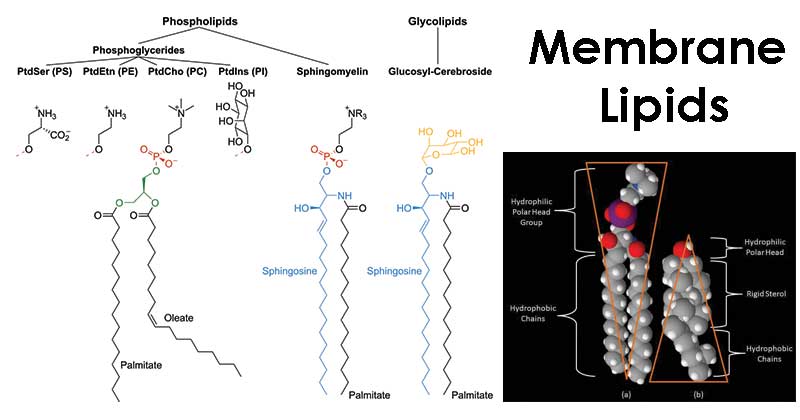Biological membranes consist of a lipid bilayer to which proteins and carbohydrates may be associated or covalently linked.
Membrane lipids are lipids involved in forming the structure of biological membranes – both the cell membrane and intracellular membranes – and in membrane function, namely compartmentalization of biological processes.
- Membrane lipids consist primarily of phospholipids, glycolipids, and cholesterol, which can be arranged in bilayers and organized with integral and peripheral membrane proteins to generate functioning membranes.
- This lipid bilayer is fluid, with individual lipid molecules able to diffuse rapidly within their own monolayer.
- The membrane lipid molecules are amphipathic and of numerous different types. The most numerous, however, are the phospholipids.
- When placed in water they assemble spontaneously into bilayers, which form sealed compartments that reseal if torn.
- The lipid compositions of the inner and outer monolayers are different, reflecting the different functions of the two faces of a cell membrane.
- Different mixtures of lipids are found in the membranes of cells of different types, as well as in the various membranes of a single eukaryotic cell.

Image: The major membrane lipids and Space-filling models of (a) sphingomyelin and (b) cholesterol. Source: Wikipedia
Interesting Science Videos
Membrane Lipid Composition
- Membranes are formed by a matrix of lipids whose structure and composition is far from simple.
- Bacterial plasma membranes are often composed of one main type of phospholipid and contain no cholesterol; their mechanical stability is enhanced by an overlying cell wall.
- The plasma membranes of most eukaryotic cells, by contrast, are more varied, not only in containing large amounts of cholesterol but also in containing a mixture of different phospholipids.
- The number of different lipid molecules found in the plasma membrane of a cell can exceed 1000.
- Membrane lipids can be classified into three main groups:
A. Glycerol‐based lipids
Glycerol‐based lipids can be divided into two broad categories: glycosylglycerides and phospholipids.
Glycosylglycerides
- Glycosylglycerides form a highly complex lipid family in which the sn‐3 position of the glycerol backbone is esterified to a glycosyl moiety (e.g. galactose, glucose, etc.).
- They are the most abundant membrane glycerolipids.
Phospholipids
- In phospholipids, while their sn‐1 and sn‐2 positions are esterified to a fatty acid, he sn‐3 position is esterified to a phosphate group that in turn is also esterified to a polar headgroup.
- Although the fatty acid moiety greatly influences their physicochemical properties, these phospholipids are usually classified according to their polar headgroup.
- Four major phospholipids predominate in the plasma membrane of many mammalian cells: phosphatidylcholine, phosphatidylethanolamine, phosphatidylserine, and sphingomyelin.
- Other phospholipids, such as the inositol phospholipids, are present in smaller quantities but are functionally very important. The inositol phospholipids, for example, have a crucial role in cell signaling.
B. Cholesterol
- Cholesterol contains a hydroxyl group that interacts with the phosphate head of phospholipids, whereas the bulky steroid region interacts with phospholipid acyl chains.
- Among other important physical properties of membranes, these interactions regulate membrane fluidity, membrane packing, non‐lamellar phase propensity and the formation of microdomains.
- Eukaryotic plasma membranes contain especially large amounts of cholesterol—up to one molecule for every phospholipid molecule.
C. Ceramide‐based sphingolipids
- Sphingolipids are defined by the presence of a sphingoid‐base backbone (i.e. 2‐aminoalk[ane or ene]1,3‐diol with 2S,3R stereochemistry).
- The main feature that allows the formation of an impermeable lipid bilayer is the amphipathic nature of these molecules, resulting in a highly hydrophobic core and hydrophilic surface, the landmark of biological and model membranes.
Membrane Lipid Structure
- Most phospholipids spontaneously form lipid bilayers in aqueous environments with a pH and ionic strength similar to that of biological systems.
- However, certain lipids can organize into non‐lamellar structures under physiological or non‐physiological conditions.
- Lipids may display different phases under different conditions (lipid mesomorphism), and may also show distinct finite structures within cell membranes (membrane microdomains).
- Membranes are made up of molecules that to some extent preserve their individual characteristics.
- Phospholipids with a bulky polar head, such as phosphatidylcholine (PC), have a cylindrical molecular or effective shape and they tend to associate with other cylinder‐like phospholipids to form planar structures.
- Other lipids might be prone to form non‐bilayer structures.
- Cone‐shaped lipids with bulky polar heads such as lysophosphatidylcholine (LPC), or truncated cone‐shaped lipids with small headgroups such as phosphatidylethanolamine (PE), may form spherical micelles or tubular structures with positive (HI) or negative curvature (HII), respectively.
Functions of Membrane Lipids
Membrane proteins have been attributed to the most important roles in membranes, although lipids have also been acknowledged as key elements in numerous processes.
- Membrane‐spanning (integral, intrinsic) proteins are permanently embedded in the lipid bilayer.
- Changes in the lipid environment of membranes regulate or alter the function of intrinsic membrane proteins.
- Peripheral (extrinsic) proteins also regulate and are regulated by membrane lipids.
- Membrane lipids participate in dynamic interactions that facilitate changes in their relative position in membranes, membrane thickness, surface packing, lateral and rotational mobility, and other properties.
- Some membrane-bound enzymes require specific lipid head groups in order to function.
- The head groups of some lipids form docking sites for specific cytosolic proteins.
- Some extracellular signals that act through membrane receptor proteins activate phospholipases that cleave selected phospholipid molecules in the plasma membrane, thereby generating fragments that act as intracellular signaling molecules.
References
- Alberts, B., Johnson, A., Lewis, J., Raff, M., Roberts, K., & Walter, P. (2002). Molecular biology of the cell. New York: Garland Science.
- https://onlinelibrary.wiley.com/doi/full/10.1111/j.1582-4934.2008.00281.x
- https://www.ncbi.nlm.nih.gov/books/NBK26871/
- https://pubs.acs.org/doi/abs/10.1021/bi00219a001
- https://www.pmf.unizg.hr/_download/repository/5_Biomembranes.pdf
- https://www.nature.com/subjects/membrane-lipids
- https://www.sciencedirect.com/topics/biochemistry-genetics-and-molecular-biology/membrane-lipids

BRO i am student…
And i am preparing csir JRF-NET i need some topics from cell biology are these good to go for net…plz kindly inform…